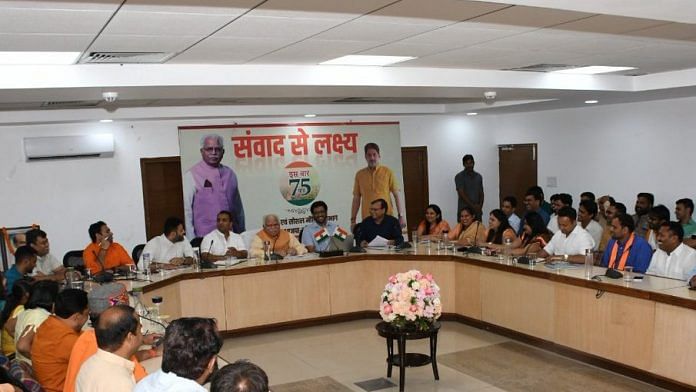Chandigarh: With the Haryana assembly elections only a few months away, the ruling BJP has launched a massive programme to strengthen its organisational structure. The state Congress that lost power in the previous elections, however, appears to be in complete disarray.
The BJP, which has been in power in Haryana since 2014, registered a stellar victory in the recently concluded Lok Sabha polls, winning all 10 seats and mopping up 58.8 per cent of the total votes cast — a new record for the party. The Congress performed abysmally, with its top leaders, including former chief minister Bhupinder Singh Hooda and state party chief Ashok Tanwar, losing by huge margins.
However, even if the Haryana Congress is worried following the Lok Sabha election results, it is not showing it. There have been no signs of any preparation for the assembly polls, as the party was awaiting a final decision on national president Rahul Gandhi’s resignation, which finally came Wednesday when he posted an open letter on his Twitter page.
Meanwhile, the BJP, which could have been forgiven for resting on its laurels, wasted no time and hit the ground running.
Also read: Five takeaways from Rahul Gandhi’s open letter
BJP’s plan
On 10 June, Chief Minister Manohar Lal Khattar met party president and Union Home Minister Amit Shah in Delhi and launched ‘Mission 75’, aiming to win 75 of the 90 assembly seats. In the 2014 polls, the BJP had won 43 seats.
“We recently held two significant meetings of senior leaders to chalk out our poll preparations. The major activities will begin with participation in the nationwide BJP membership drive starting on 6 July, and culminate in a fortnight-long Rath Yatra just before the assembly elections are likely to be announced,” said state BJP chief Subhash Barala.
“On 29 June, we held a meeting of our extended state executive. Each of the BJP ministers, MLAs and other senior leaders of the party have been assigned 2-3 mandals, whose results they’ll be responsible for,” he added.
The 90 assembly constituencies in Haryana have been divided into 290 mandals. Each mandal has 10 to 12 ‘Shakti Kendras’, a smaller unit for which the local level leadership is responsible. A Shakti Kendra is a cluster of 5-6 booths. On an average, a booth has almost 1,500 votes.
On 6 July, the BJP will begin its membership drive in the state, which will continue till 28 July. “Right now, we have 33 lakh members in Haryana, and we expect to increase the membership by at least 20 per cent, expecting to add more than 6 lakh members,” Barala said. “There is a lot of enthusiasm among the people to join the BJP, and it will be visible during the membership drive. Members from all castes and social groups will be taken into the BJP.”
Also read: Haryana makes a poll move — will fund Dalit trips to Kabir, Ravidas & Valmiki shrines
Congress in total disarray
In contrast to the BJP, the Congress leaders seemed to be twiddling their thumbs as they waited for the final word on Rahul Gandhi’s resignation.
Members of the state coordination committee headed by former CM Bhupinder Singh Hooda met Gandhi recently to persuade him not to resign as party president.
“We also apprised him of the situation of the party in the state. We are awaiting a decision from his side,” Hooda had said after the meeting.
Losing precious time with each passing day, the faction-ridden state leadership is not making any efforts on the ground either, waiting for the high command to decide who will lead the party into the elections.
Hooda’s supporters met him at his residence on 11 June and asked him to take over the reins of the party. Meanwhile, Tanwar, who was held responsible for the party’s humiliating defeat during a review meeting called by state in-charge Ghulam Nabi Azad last month, refused to resign from his position. Hooda and Tanwar are at loggerheads, and the former’s camp demanded the latter’s ouster at the meeting.
After years of intense infighting, the Haryana Congress even lacks a basic organisational structure. In 2015, Tanwar put up a team of vice-presidents and general secretaries, but the Hooda faction refused to accept the nominations, saying it was not consulted. The same year, Tanwar set up a 52-member executive committee, which never met.
Earlier this year, when Tanwar put a team of 90 leaders in charge of all the assembly seats, the list was rejected by Hooda and his supporters. The party has no district- or block-level president, considered to be the crucial link between the party and its voters.






